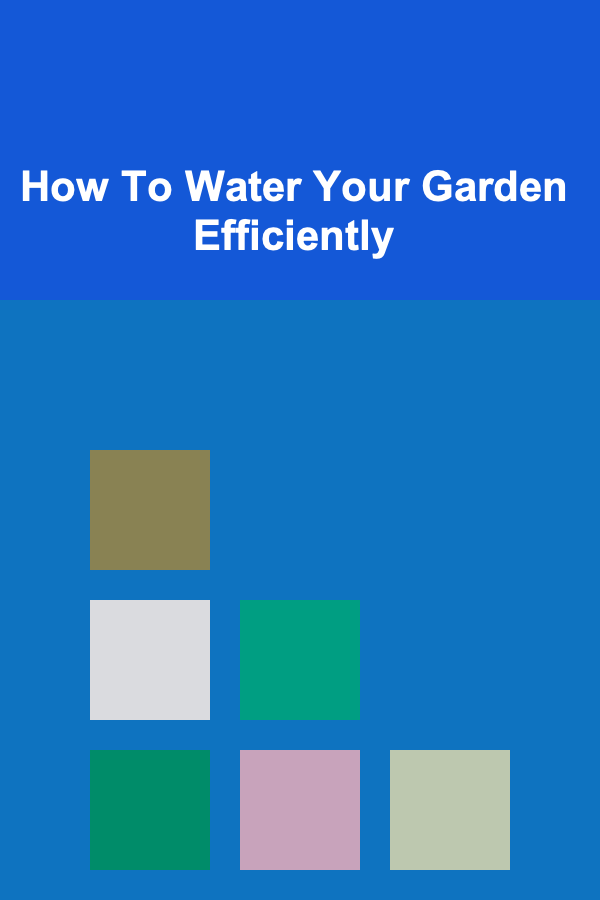
How To Water Your Garden Efficiently
ebook include PDF & Audio bundle (Micro Guide)
$12.99$7.99
Limited Time Offer! Order within the next:

Watering your garden might seem like a simple task, but the way you go about it can make a significant difference in your plants' health, your water bill, and the overall environmental impact. Efficient watering is key to ensuring that your garden thrives, while also conserving this precious resource. Whether you're a seasoned gardener or just starting out, understanding how to water your garden efficiently is one of the most important steps toward achieving a healthy and sustainable garden.
In this article, we'll explore the importance of watering your garden efficiently, the techniques you can use, how to select the right irrigation system, and how to address specific needs based on the plants in your garden.
Why Efficient Watering Matters
Water is an essential component for plant growth, and the way it is delivered to your garden can influence the success of your plants. Overwatering or underwatering can both lead to significant issues, ranging from root rot to dehydration. Additionally, water waste is a growing concern in many parts of the world, particularly in regions experiencing drought or water shortages.
When you water efficiently, you reduce the risk of plant stress and disease, conserve water, and save money. Efficient watering also helps maintain a healthy ecosystem by promoting root development and minimizing soil erosion. By making smart choices about how and when to water, you can ensure that your garden thrives while being environmentally conscious.
Key Principles of Efficient Watering
Before diving into specific techniques and systems, it's important to grasp some basic principles of efficient watering:
1. Watering Deeply and Infrequently
Plants need deep watering to encourage healthy root development. Shallow watering, where you just wet the surface of the soil, leads to shallow roots that make plants more vulnerable to drought and stress. On the other hand, deep watering encourages plants to develop strong, deep root systems that can better access water in the soil.
Watering infrequently but deeply ensures that the soil retains moisture for longer periods and prevents water wastage. It also mimics the natural rainfall cycle, where water is often delivered in large quantities over a short period.
2. Watering at the Right Time
The timing of watering is crucial for both plant health and water conservation. Early morning or late evening is the best time to water your garden. Watering during the hottest part of the day (usually midday) leads to significant evaporation, meaning much of the water will be lost before it even reaches the plant roots.
Morning watering allows the plants to absorb the moisture before the heat of the day sets in, reducing water loss through evaporation. Evening watering should be avoided in areas with high humidity, as it can create an environment conducive to fungal diseases.
3. Soil Type and Its Water Holding Capacity
Different soil types have varying capacities for holding water. For example, sandy soil drains quickly and doesn't retain moisture for long, while clay soil holds water for extended periods. Knowing the soil type in your garden will help you adjust watering schedules and quantities.
For sandy soils, you may need to water more frequently but in smaller amounts. In contrast, for clay soils, deep watering less frequently may be more effective. Regularly testing your soil will help you understand its moisture retention capacity.
4. Use of Mulch
Mulch is a valuable resource for conserving water in your garden. It helps retain soil moisture, suppresses weeds, and regulates temperature. Organic mulches like wood chips, straw, or leaves break down over time and enrich the soil, improving its ability to retain water. When mulching, ensure that the layer is thick enough to help with water retention but not so thick that it prevents water from reaching the roots.
Techniques for Efficient Watering
With the basic principles in mind, let's explore some techniques you can implement to water your garden more efficiently.
1. Drip Irrigation
Drip irrigation is one of the most water-efficient methods available. This system delivers water directly to the base of plants via tubes or hoses, allowing water to drip slowly and evenly to the soil. Drip irrigation minimizes evaporation and runoff, ensuring that the plants receive the necessary amount of water without waste.
Drip systems can be customized to suit different plant types and garden layouts. You can install drip emitters or use soaker hoses to ensure that water reaches the root zone. The setup can be automated with timers to make watering more convenient, reducing the need for manual intervention.
2. Soaker Hoses
Soaker hoses are another efficient watering solution. These hoses are porous, allowing water to seep out slowly along their length. By laying soaker hoses across your garden beds, you ensure that water is delivered gradually and evenly to the roots of plants. This method works especially well for vegetable gardens and flower beds.
The advantage of soaker hoses is that they cover a large area and can be easily moved around. They also help reduce water wastage by preventing evaporation and runoff.
3. Sprinkler Systems
While not as water-efficient as drip irrigation or soaker hoses, sprinkler systems can still be effective when used properly. To maximize their efficiency, use sprinklers that are designed for specific needs. For instance, oscillating sprinklers are good for lawns, while rotating sprinklers are better for smaller garden areas.
When setting up sprinklers, make sure they're positioned in a way that minimizes overspray onto paved areas or areas where plants don't need water. Consider using timers to avoid overwatering, and adjust the sprinkler heads to ensure that water is distributed evenly across the garden.
4. Hand Watering with a Hose or Watering Can
Although it can be time-consuming, hand watering with a hose or watering can gives you more control over how much water each plant receives. It's a great option for small gardens, container plants, or plants that have specific water needs. Use a gentle nozzle attachment for the hose to avoid disturbing the soil or damaging delicate plants.
For more precision, water deeply at the base of each plant, and avoid wetting the leaves, as this can promote fungal growth. Hand watering is also an excellent way to monitor your plants closely and catch any issues early on.
5. Rain Barrels
Rain barrels are an eco-friendly way to collect and store rainwater for use in your garden. By harvesting rainwater, you can reduce your reliance on municipal water systems and save money on your water bill. Rain barrels can be connected to downspouts to collect runoff from your roof.
Once the barrel is full, you can use the collected water to irrigate your garden. Many rain barrels come with hoses or spigots for easy water access. Just be sure to keep the water clean and use it promptly, as standing water can become a breeding ground for mosquitoes.
6. Smart Irrigation Systems
Smart irrigation systems are becoming increasingly popular due to their ability to optimize water usage based on weather conditions, soil moisture levels, and plant types. These systems use sensors to monitor the moisture in your soil and adjust the watering schedule accordingly. Some smart systems can even be controlled via an app, allowing you to track water usage and adjust settings from anywhere.
By investing in a smart irrigation system, you can ensure that your plants receive the exact amount of water they need without excess, which saves water and money in the long run.
Factors Affecting Watering Efficiency
While the watering methods themselves are important, several factors can affect the efficiency of your watering efforts. These include:
1. Climate and Weather Conditions
The local climate plays a significant role in determining how much water your garden needs. In hot and dry climates, plants will require more water, while in cooler or more humid regions, less frequent watering may be needed. Be sure to adjust your watering schedule based on current weather conditions. For example, after heavy rainfall, you can skip watering for a few days.
2. Plant Type
Different plants have different water needs. Drought-tolerant plants such as succulents and cacti require far less water than vegetables like tomatoes or lettuce. When planning your garden, group plants with similar water needs together to make watering more efficient. This way, you avoid overwatering plants that don't need much moisture while ensuring that thirstier plants get enough.
3. Soil Moisture Levels
Regularly checking the moisture levels of your soil is a good way to ensure you're not over- or underwatering your garden. Use a soil moisture meter to measure the moisture level at different depths, or simply dig a small hole and check the soil by hand. If the soil feels dry several inches below the surface, it's time to water. Conversely, if it feels wet, wait a few days before watering.
Conclusion
Efficient watering is a cornerstone of sustainable gardening. By using the right watering techniques and systems, you can ensure that your plants are well-hydrated without wasting water. Whether you choose drip irrigation, soaker hoses, or rain barrels, each method offers unique advantages depending on your garden's needs. Combine these techniques with an understanding of your soil type, plant needs, and local climate, and you'll be on your way to a flourishing, water-efficient garden.
In addition to conserving water, efficient watering leads to healthier plants, fewer pests, and reduced environmental impact. As gardeners, it's our responsibility to make thoughtful decisions about how we use water, ensuring that this precious resource continues to nourish our gardens and sustain our ecosystems for years to come.

How to Create a Tool Maintenance Schedule
Read More
How to Master Comparison Shopping Before Making a Purchase and Save Big
Read More
How to Stage Your Home's Backyard for a Relaxing Outdoor Retreat
Read More
How To Understand the Future of Decentralized Autonomous Organizations
Read More
The Ultimate Guide to Affordable Meal Planning for Busy Families
Read More
How To Open a Florist Shop: A Comprehensive Guide
Read MoreOther Products

How to Create a Tool Maintenance Schedule
Read More
How to Master Comparison Shopping Before Making a Purchase and Save Big
Read More
How to Stage Your Home's Backyard for a Relaxing Outdoor Retreat
Read More
How To Understand the Future of Decentralized Autonomous Organizations
Read More
The Ultimate Guide to Affordable Meal Planning for Busy Families
Read More